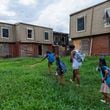The AJC shared an inspiring story this weekend about the first Maynard Jackson High School graduate to attend Harvard.
Bound this fall to Harvard on a full scholarship, Atlanta whiz kid Marisela Lozada earned that rare distinction without a parent to plot her academic path or cheer her on; she lost her mother as a young girl.
It was her mother who celebrated education as a route out of poverty. While Marisela had a loving father, he was not involved in her schooling or concerned about whether she made good grades or went to college.
As the story reports:
Even in elementary school, Marisela said, she felt compelled to do well. She states it as a fact, with no luster. "I've always been a good student." She remembers her early years, when everyone tried to do well in class. But something happened, she recalled, in middle school. Some of her friends (and, truth told, her siblings) seemed to lose interest in academic excellence about the time they hit puberty. They no longer had la cabeza, the head for education.
Marisela, instead, bore down. Why?
"Honestly? Education is something I have control of," she said. "It keeps me busy."
As the AJC story notes, her mother’s death fueled Marisela’s resolve to excel. "If she hadn't passed away, I don't think I'd be in the position I am in today, honestly," she told journalist Mark Davis. "I wouldn't have tried my hardest or my best."
What makes one child faced with adversity crumble under the weight of it and another find the strength to push through it? How do we get students to care as much about their education as Marisela, who set her own bar and then relied on her own personal drive to exceed it?
Stories like Marisela's remain rare, which is why she ended up on the front page of the AJC. Most students at Ivy League campuses come from families where excellence is expected, nurtured and funded. A New York Times report found about four in 10 students from the top 0.1 percent of household wealth end up at an Ivy League or elite university. Several friends have children in the Ivies, and the kids return to Georgia with tales of classmates whose parents own a Manhattan apartment, a Colorado ski chalet and a Paris pied-a-terre.
There’s a lot we don’t understand about the sort of resilience Marisela demonstrated. Science may find a genetic component to the people who bounce back, who regroup after loss rather than succumb to it.
But it seems unfair to expect children with scant advantages or advocates to somehow conjure inspiration and motivation, to search within themselves for the map to success that other kids are handed at birth.
A few years back, we were all talking about grit, which was defined as a child’s ability to set a goal and stick with it. The grit narrative has largely been cast aside. As ed reformer Diane Ravitch said, “The notion that kids in poverty can overcome hunger, lack of medical care, homelessness, and trauma by buckling down and persisting was always stupid and heartless, exactly what you would expect to hear from Scrooge or the Koch brothers or Betsy DeVos.”
Neurobiology is revealing that being born into poverty can impede brain growth. The studies suggest brain structures vital to the learning process -- sustained attention, planning, and cognitive flexibility – can be affected by stress, limited stimulation, and poor nutrition.
One study found:
Poverty is tied to structural differences in several areas of the brain associated with school readiness skills, with the largest influence observed among children from the poorest households. Regional gray matter volumes of children below 1.5 times the federal poverty level were 3 to 4 percentage points below the developmental norm. A larger gap of 8 to 10 percentage points was observed for children below the federal poverty level. These developmental differences had consequences for children's academic achievement. On average, children from low-income households scored 4 to 7 points lower on standardized tests. As much as 20 percent of the gap in test scores could be explained by maturational lags in the frontal and temporal lobes.
Yes, we want children to persevere and triumph over obstacles, but we can’t pretend there aren’t powerful political, economic and social forces that constrain them. We should celebrate children who overcome these gale force winds but also recognize that many more stumble and fall because of them.







